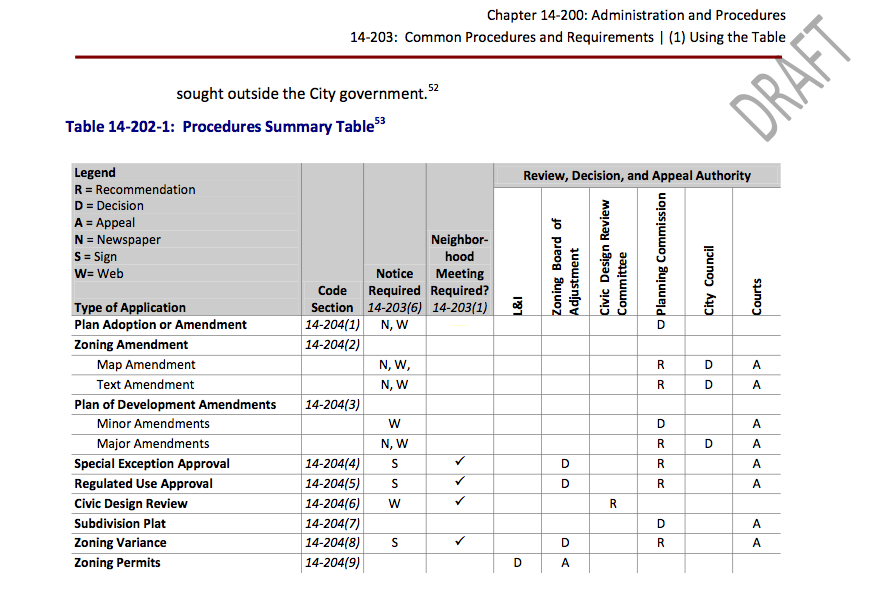Cutting through the Zoning Code: “Administration and Procedures”

You hear the phrase “administration and procedures,” and your eyes might glaze over as your mind drifts to the National League Championship Series. But unless you read the code, how are you going to know if it’s sexy?
OK, procedures? Not that sexy. Sorry to disappoint. This section lays out how administrative processes should work under the revised code and gives the first details of some of the major procedural changes, including Registered Community Organizations (RCOs), Civic Design Review (CDR), new notification procedures, and the discouragement of use variances. Not everything is entirely clear yet—for example, the Zoning Code Administrative Manual, which governs many of the “how” details, is not yet finalized.
Still, let’s not forget our governing questions. Can I, your representative layman, understand it? And if I can, what’s new?
Sometimes, footnotes tell the tale. One, to the City Council’s power to approve subdivisions of land, reads, “This replaces current language stating that Council will approve SP-ENT districts [where arcades, casinos, and pool halls are allowed], Industrial Transformation Districts, RC-6 districts, Waterfront Redevelopment Districts, and Neighborhood Conservation Districts, because those are all amendments to the official zoning map that require Council anyway.” What that means: the code already does this elsewhere, so the bloat is cut by not including it here. A good start!
As for new things, the section offers a handy “Procedures Summary Table” that shows what arms of the city have what role in zoning decisions, and details the cases where public notices and neighborhood meetings are required. And the section on what expansions are allowed for nonconforming buildings translates about 700 words of code into three easy-to-grasp illustrations.
Another newbie, section 14-201(4)(b)(.8) integrates a City Council bill passed earlier this year. The bill demands anybody seeking special exceptions, variances, or approvals from the Zoning Board of Adjustment (ZBA) to prove they’ve paid their taxes. For a city that’s been facing revenue shortfalls for some years now, this pay-what-you-owe-to-play provision might be a good idea.
The civic associations, which have engaged in tete-a-tetes with large developers, now have a formal if advisory role. Property owners must notify the surrounding community in four cases: when seeking a special exception approval, a regulated use approval (for uses like adult stores, gun shops, jails), a civic design review, or a zoning variance. The burden is on the applicant, in all cases, to show that any exceptions are, in essence, consistent with the Planning Commission’s overall idea for how development should be moving forward. That is, consistent with the comprehensive plan, unlikely to overcrowd the land or the streets, ecologically sound, and so forth. In fact, requests for zoning variances go before the Planning Commission before they even get to ZBA.
The RCOs, in order to be notified, must register with the Planning Commission every year, and provide a contact name, a person who will participate in any necessary civic design review, the area it covers, and whether it wants paper or email notification. Groups that represent the same area or who overlap the area where a project will occur must team up for a single meeting within 21 days of receiving notice. Within 30 days, both the RCO and the applicant must file a report on the meeting and submit it to the ZBA or the CDR Committee.
The ZBA and the CDR Committee cannot discuss the application until those 30 days have passed—the time is intended to let all parties get their ducks in a row and submit their reports before the application is reviewed. Developers are likely to appreciate this policy, which means they won’t have to make the rounds to a number of different meetings with different groups. The neighborhood and civic associations? We’ll see what they think in a future story.
Neighborhood groups also have a formalized role in Civic Design Review. CDR will be triggered in three cases, and the CDR Committee exists to advise developers about the potential public impact of major projects. The commission will consist of seven members, according to the code, “two architects, one landscape architect, one transportation/urban planner, one developer/builder, one person with civic association review experience, and one rotating seat for a representative of a Registered Community Organization located in the Project Area.” Except for the RCO representative, the members will be mayoral appointees, making the CDR Committee necessarily a political body.
That the CDR Committee’s makeup will be political in nature probably won’t matter, though, because the committee’s recommendations will be just that: recommendations. The code makes very clear that the committee is advisory, and if a project is “of right”—that is, if it complies with the zoning code and maps—it can move forward, regardless of what its neighbors may think.
Finally, the code states explicitly, “Use variances are discouraged.” Makes sense—jails might be necessary, but not a lot of people want a new jail built on a residential block. The idea here is that after the Zoning Code is revised, and after the city goes through a remapping process early next year, the map of the city will better reflect the actual (and anticipated) uses of land and buildings, thus minimizing the need for use variances. Will this work? We won’t know until everything’s done, but with half of ZBA cases being use variances, any reduction will streamline appeals for all other issues.
Next time, in Cutting through the Zoning Code: Base Zoning Districts! (And if you’re lucky, I’ll throw some Overlay Districts in there as a sweetener.)
Contact the reporter at ngilewicz@planphilly.com
WHYY is your source for fact-based, in-depth journalism and information. As a nonprofit organization, we rely on financial support from readers like you. Please give today.



